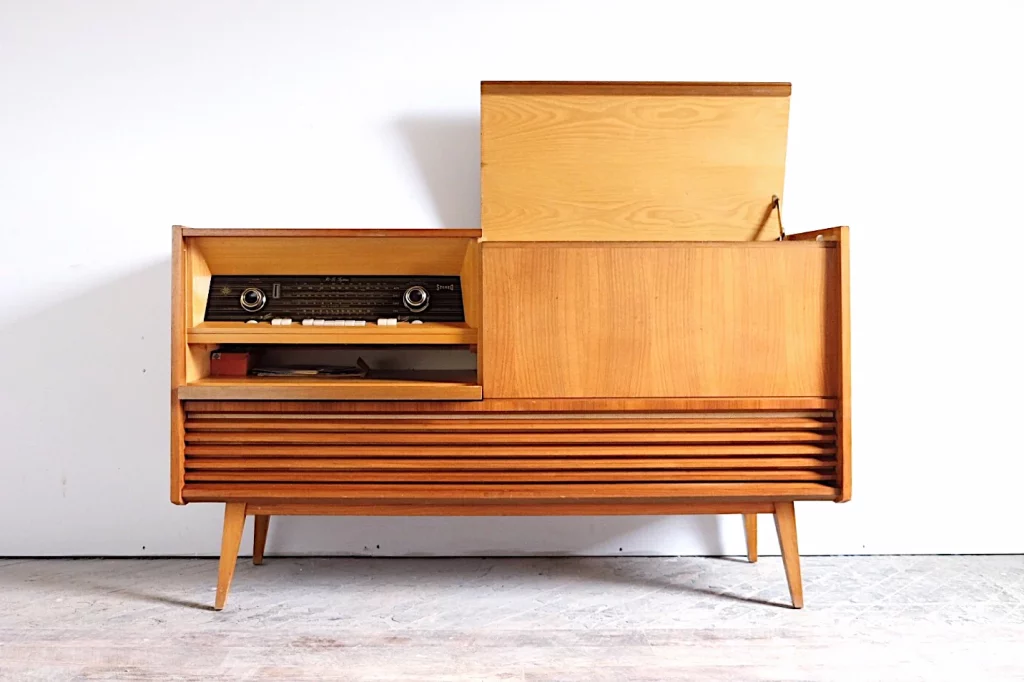Telefunken is a reputable German electronics company known for manufacturing a wide array of products over its century-long history. The company’s stereo consoles, in particular, have been a significant part of its legacy. Here’s a brief Telefunken stereo console history.
Origins and Early Innovations – 1900s to 1940s
Telefunken began in 1903 as a joint venture between Siemens & Halske and AEG (Allgemeine Elektricitäts-Gesellschaft). Initially, the company specialized in radio and television technology, becoming one of the leading manufacturers in these areas.
Entry into Stereo Consoles – 1950s to 1960s
Telefunken expanded its production line to include stereo consoles in the mid-1950s, responding to a growing demand for high-fidelity home audio systems. These consoles were furniture-style units typically housing a radio tuner, a record player, and sometimes a tape deck. Known for their superior sound quality, precision engineering, and stylish designs, Telefunken’s stereo consoles quickly gained popularity.
Heyday – 1960s to 1970s
The 1960s and 1970s marked the golden era of Telefunken stereo consoles, which were known for quality and innovative features. Some of the popular models during this time included the “Concerto” and “Allegro” series. Telefunken products were not only popular in Germany but were also exported extensively, particularly to other European countries and the United States.

Here’s a list of the most popular Telefunken models:
- Telefunken Symphony 105: This model was introduced in 1963 and featured a powerful amplifier, a variety of inputs and outputs, and a stylish wood cabinet.
- Telefunken Orchestra 104: This model was introduced in 1965 and was similar to the Symphony 105, but it had a few additional features, such as a built-in AM tuner and a remote control.
- Telefunken Allegro 103: This model was introduced in 1967 and was designed to be a more affordable alternative to the Symphony and Orchestra models. It featured a smaller cabinet and a less powerful amplifier, but it still offered high-quality sound reproduction.
Transition and Challenges – 1980s to 1990s
The 1980s and 1990s brought new challenges for Telefunken. With the advent of more compact and portable digital music formats, demand for traditional stereo consoles began to decline. Like other manufacturers, Telefunken had to adapt its product line to keep up with these changes, introducing more modern systems that incorporated technologies like CD players. However, the company struggled to maintain its market position amidst these shifts.
Present Day – 2000s and Beyond
While Telefunken has stopped producing traditional stereo consoles, their vintage models remain highly popular among audiophiles and collectors. The quality build and sound of these units, combined with their mid-century design aesthetics, make them coveted pieces in the vintage audio market. As of my knowledge cutoff in 2021, Telefunken continues to operate, focusing on a range of audio products and other electronics.
Telefunken’s stereo consoles represent an essential chapter in the history of home audio systems. Telefunken’s are known for quality and craftsmanship. These consoles encapsulate the company’s commitment to delivering superior audio experiences, and their vintage models continue to be celebrated in the audio enthusiast community.
Thnking about buying one? Read our stereo console buyer’s guide then check out our stereo console marketplace for available Telefunkens.